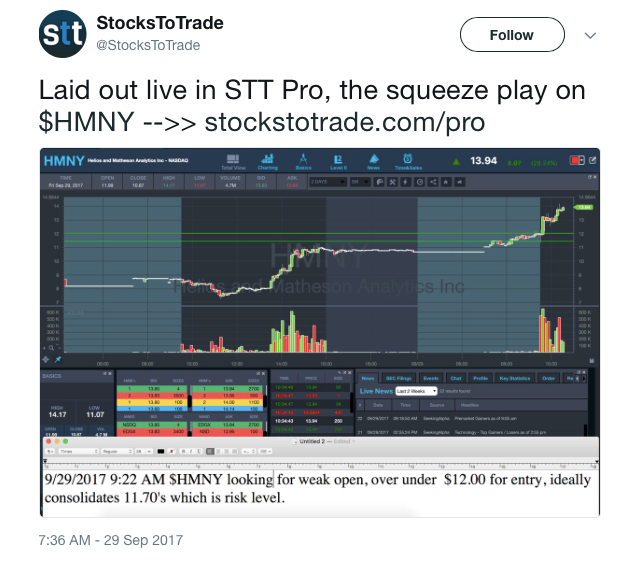Win With A Trading Plan
Consistently profitable traders have a trading plan . Those who don’t have a plan will fade away, never to be heard from again.
That is a fact.
STT lead trainer Tim Bohen has been trading for 40 years—and he’s still here because he has a plan, always and for every single trade.
It’s not good to drag your feet in the trading world, but one of the biggest mistakes traders make is jumping into something without a plan. Having goals set in advance and knowing when to get out of a trade are not only important—they are crucial. If you want to succeed, this is a definite must.
Download a PDF version of this post as PDF.
“I know I’ve said it a million times, but I’ll keep saying it until it sinks in: If you don’t have a plan, then plan to fail,” says Tim.
Always identify your goals, organize your market research, be prepared to take a risk and manage loss, and always know when you going to get in and out.
One of the most important parts of your plan should be to define your stop loss, and always stick to it.
“Nothing will blow up a trader faster than ignoring your stop loss and moving on. Nobody writes a trade plan that says, ‘I’m going to lose a half of my account on this trade’. But do they lose half of their account on their trade – Yes,” says Tim.
In fact, it happens over and over again.
Before any trade, ask yourself if you are truly prepared, on every level, from potential risk to potential reward.
As STT’s lead trainer, Tim shares his plans for potential plays with traders like you every day, discussing 5-10 stocks a day so there’s something for everyone. Here’s from 29 September:
This one ticked all the boxes for what Tim looks for in a trade, and he lays it all out for you in this plan.
The plan for $HMNY was to hope for a weak open, with a defined stop loss at $11.75—which means that’s exactly when you should exit because it’s the danger zone. The stock opened under $12 and then reclaimed $12. Then it hit $14 in morning trading. That’s when you should have sold it if you bought it. You would have made nice gains in just a couple of hours. If you didn’t sell it, you’re getting too greedy. By noon, the stock was back down to $12.75. Not close to the danger zone, but not the nice returns you would have gotten at $14.
So, what it if went past $14 after you sold it? Well, you still won. We’ll talk more about this in a later article, but for now suffice it to say that this is how wins turn into losses. For the best and most consistent wins, it’s best to leave the party when things are still good.
There are various types of orders offered by online brokers that are designed to protect investors from significant losses. The most commonly used order is a stop loss, but another type of order should be considered: the trailing stop.
Stop Loss: This is one of the most common methods for limiting the amount of loss from a declining stock. The trader places a stop-loss order, fixing the value based on the maximum loss he or she is willing to absorb. If the price drops below this, the position will be closed at the current market price, preventing any further losses.
Trailing Stop: A trailing stop provides the same amount of protection, but it’s more flexible than a stop loss order. It automatically shadows the price movement. So what it’s doing, essentially, is following the stock’s price action when it rises. It self-adjusts.
However, Tim Sykes, for example, doesn’t use an automatic stop loss marker because market makers can see your orders and move the price to that level, then back up just to take you out and earn commissions. Instead, he uses mental stop losses so market makers can’t see what his get-out point is, but he still gets out if and when the stock reaches that point.
If you want to do it this way, though, you have to be disciplined and stick to your mental stop losses–not to mention tied to your computer so you’re there to execute your exit at the moment that marker occurs.
When it comes to your stop loss—nothing is more critical to your success. Don’t be afraid to lose. It’s a part of trading, and it quite simply cannot be avoided. As long as you control your losses by sticking to your plans and stop losses, it’s not frightening. It’s all about control.
“Not all losses are a result of doing something ‘wrong’,” says Tim. “No setup is going to work 100% of the time. Sometimes it will fail and you will take that unavoidable loss, and that’s fine. Again, just stick to your plan and your stop losses and control the loss.”
We’ve used the example of Jim Cramer before, but it works here, too. Again, Cramer only has a 35% win rate—and he was wildly successful. He’s always got a plan, so he always makes sure that his wins exceed his losses.
If you cut your losses to early; if you follow a plan; you can get to the point where you show up each day and your $100 becomes $200 or $500–repeatedly.
So again, to sum up Tim Bohen’s 5 steps: Look for big moves, catalysts, volume and always have a plan to minimize your losses. It all goes back to the plan, and that’s what we talk about every single day on STT pro.
You can learn more about Tim’s 5 steps if you’re an STT Pro member on our webinars, but be sure to check out our new series of Podcasts on Steady Trade!

